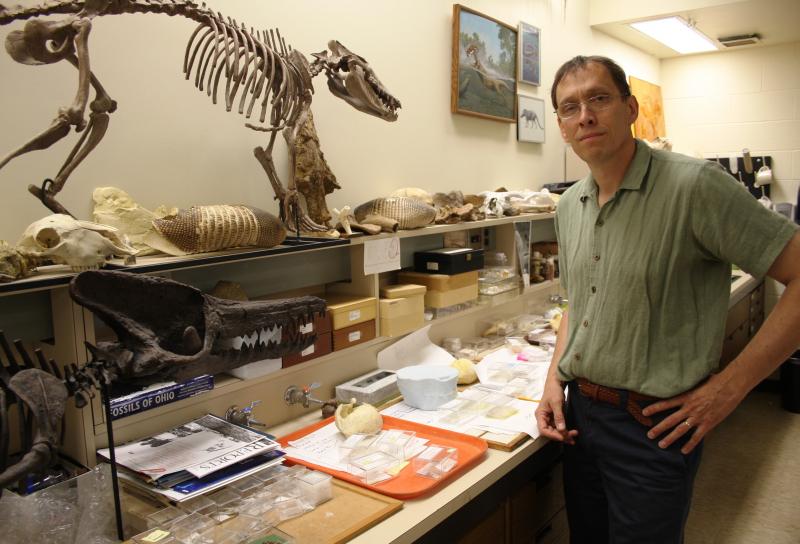Science and Technology

Monday, August 4, 2014
Exploradio: In search of walking whales
A northeast Ohio fossil hunter documents his discoveries of the earliest ancestors of whales in a new book
by WKSU's JEFF ST. CLAIR
This story is part of a special series.
|

Reporter / Host
Jeff St. Clair | | |
 | | Pakicetus sits at the base of the whale family tree, pictured here hunting fish 49 million years ago in what is now northern Pakistan. | | Courtesy of Hans Thewissen |
A new book by an Ohio author unravels what used to be one of the greatest mysteries of science. It’s the story of how whales and dolphins came to be fully adapted to aquatic life.
In this week’s Exploradio, WKSU’s Jeff St.Clair talks with the fossil hunter who traces the path whales walked in their journey from land to the sea.
|
Exploradio: Walking WhalesOther options:  MP3 Download (3:41) MP3 Download (3:41)
|
A broken ear tells a tale
The story of whales begins far from the ocean, high in what are now the Kashmiri mountains of northern India. That’s where, 50 million years ago, a tiny deer-like creature skittered through lush forests. It's called Indohyus and Northeast Ohio Medical University anatomy professor Hans Thewissen says no one really knew what kind of animal it was until his lab assistant confessed to an accident.
 He'd snapped off part of the skull while cleaning it, and Thewissen says, "the part he had broken was just the ear.” He'd snapped off part of the skull while cleaning it, and Thewissen says, "the part he had broken was just the ear.”
But that was enough. Thewissen says this lucky accident allowed him to recognize that Indohyus was a whale because whale ears, both living and extinct, have a special shape that identifies the family. And the ears of this cat-sized water deer have that unique structure.
But why did Indohyus run into the water? Thewissen thinks it was to avoid being eaten. He says, “it was living on land, but it would always jump in the water as a means of predator escape and that’s how we now think that whales got their start.”
A modern animal called the mouse deer has a similar survival strategy today.
Pakicetus, the first whale
Thewissen shows me a metal cabinet filled the perfectly preserved bones of a later, dog-like whale that Thewissen found in the remote hills of northern Pakistan.  This sheep in wolf’s clothing had hooves, but unlike Indohyus, Pakicetus, or Pakistan’s whale, was a meat eater. Its ears, and sharp, serrated teeth, make it the first whale, according to Thewissen. He says Pakicetus sits at the base of the family tree that 49 million years ago led to today's whales, dolphins, and porpoises. Pakicetus mostly waded in the water in fresh-water rivers and streams, but Thewissen says its descendant, the Ambulocetus, or walking whale, was truly adapted to life in the sea. This sheep in wolf’s clothing had hooves, but unlike Indohyus, Pakicetus, or Pakistan’s whale, was a meat eater. Its ears, and sharp, serrated teeth, make it the first whale, according to Thewissen. He says Pakicetus sits at the base of the family tree that 49 million years ago led to today's whales, dolphins, and porpoises. Pakicetus mostly waded in the water in fresh-water rivers and streams, but Thewissen says its descendant, the Ambulocetus, or walking whale, was truly adapted to life in the sea.
Paddling in the ocean
Ambulocetus, he says,“is a lot bigger...about the size of a big male sea lion.”
Ambulocetus was an ocean hunter that used its huge back feet to swim around the shorelines of an ancient Indian sea.  But over the next few million years, walking whales began swimming less with their feet and more with their tails, like their modern relatives do. But over the next few million years, walking whales began swimming less with their feet and more with their tails, like their modern relatives do.
In his lab, Thewissen shows me the skeletons of several bizarre looking creatures with long narrow snouts, short legs, and long, strong tails.
“This is the most freakish of all of them I think."
It's called Kutchicetus after the region of India where he discovered it. "I don’t think he was scary in terms that he would eat you like Ambulocetus would, but he’s definitely freakish looking,” says Thewissen.
Over time, new animals appeared with ever smaller legs. And around 40 million years ago, the world became populated with what we would recognize as a whale, despite its tiny, dangling hind legs. Thewissen says, “Evolution quickly sorts out some winners and losers and comes up with this great body form that modern whales have. And then all these forms that I’m studying go extinct.”
Filling the gaps in evolution
A skeleton of Ambulocetus, the walking whale, hangs in the atrium of the medical school just outside Thewissen’s lab. Thewissen says what for centuries had been a great scientific mystery, has in the past 15 to 20 years become one of the best examples of evolution. He says "the biology textbook of my son in high school has whales as the example of how the fossil record documents evolution. So it’s pretty exciting to see that happen.” Thewissen says what for centuries had been a great scientific mystery, has in the past 15 to 20 years become one of the best examples of evolution. He says "the biology textbook of my son in high school has whales as the example of how the fossil record documents evolution. So it’s pretty exciting to see that happen.”
The result of two decades of exploration, he says, “has been a very exciting ride.”
Thewissen’s new book, ‘The Walking Whales,’ details his adventures hunting fossils in Pakistan and India. It’s set to be released this fall. |
(Click image for larger view.)
|
|